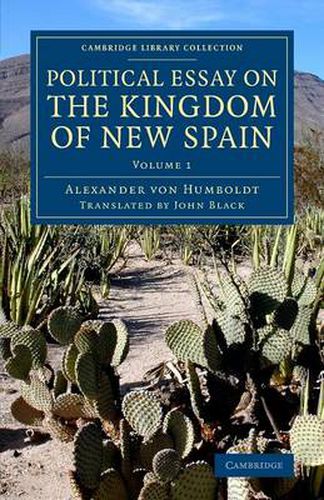Readings Newsletter
Become a Readings Member to make your shopping experience even easier.
Sign in or sign up for free!
You’re not far away from qualifying for FREE standard shipping within Australia
You’ve qualified for FREE standard shipping within Australia
The cart is loading…






The acclaimed Prussian naturalist Alexander von Humboldt (1769-1859) was referred to by Charles Darwin as ‘the greatest scientific traveller who ever lived’. Several of his works were in the library aboard the Beagle, including the multi-volume Personal Narrative of Travels, two books on geology and Tableaux de la nature (all reissued in the Cambridge Library Collection). Darwin’s copy of this two-volume 1811 New York edition of Humboldt’s Political Essay (originally published in French earlier that year) is inscribed ‘Buenos Ayres’, suggesting he acquired it there in 1832-3, without its accompanying atlas (forthcoming). Humboldt had spent a year in Mexico in 1803-4, and was struck by its ‘civilization’ as compared to regions of South America that he had visited earlier on his expedition. Volume 1 of his account contains a ‘geographical introduction’ and discussions of physical geography, agriculture, and the ethnic diversity, distribution and health of the population.
$9.00 standard shipping within Australia
FREE standard shipping within Australia for orders over $100.00
Express & International shipping calculated at checkout
The acclaimed Prussian naturalist Alexander von Humboldt (1769-1859) was referred to by Charles Darwin as ‘the greatest scientific traveller who ever lived’. Several of his works were in the library aboard the Beagle, including the multi-volume Personal Narrative of Travels, two books on geology and Tableaux de la nature (all reissued in the Cambridge Library Collection). Darwin’s copy of this two-volume 1811 New York edition of Humboldt’s Political Essay (originally published in French earlier that year) is inscribed ‘Buenos Ayres’, suggesting he acquired it there in 1832-3, without its accompanying atlas (forthcoming). Humboldt had spent a year in Mexico in 1803-4, and was struck by its ‘civilization’ as compared to regions of South America that he had visited earlier on his expedition. Volume 1 of his account contains a ‘geographical introduction’ and discussions of physical geography, agriculture, and the ethnic diversity, distribution and health of the population.